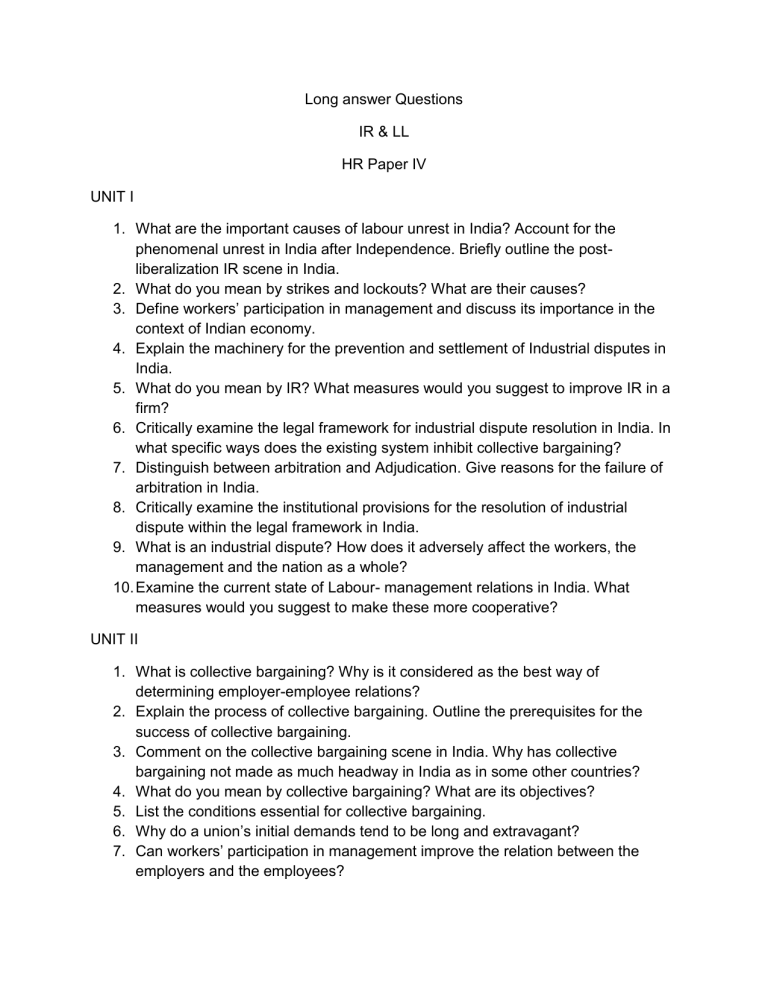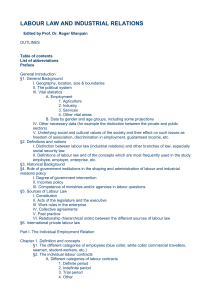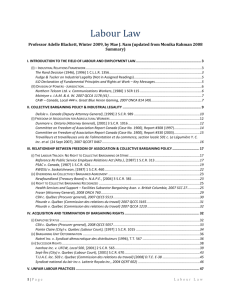Long answer Questions

Long answer Questions
IR & LL
HR Paper IV
UNIT I
1. What are the important causes of labour unrest in India? Account for the phenomenal unrest in India after Independence. Briefly outline the post- liberalization IR scene in India.
2. What do you mean by strikes and lockouts? What are their causes?
3. Define workers’ participation in management and discuss its importance in the context of Indian economy.
4. Explain the machinery for the prevention and settlement of Industrial disputes in
India.
5. What do you mean by IR? What measures would you suggest to improve IR in a firm?
6. Critically examine the legal framework for industrial dispute resolution in India. In what specific ways does the existing system inhibit collective bargaining?
7. Distinguish between arbitration and Adjudication. Give reasons for the failure of arbitration in India.
8. Critically examine the institutional provisions for the resolution of industrial dispute within the legal framework in India.
9. What is an industrial dispute? How does it adversely affect the workers, the management and the nation as a whole?
10. Examine the current state of Labour- management relations in India. What measures would you suggest to make these more cooperative?
UNIT II
1. What is collective bargaining? Why is it considered as the best way of determining employer-employee relations?
2. Explain the process of collective bargaining. Outline the prerequisites for the success of collective bargaining.
3. Comment on the collective bargaining scene in India. Why has collective bargaining not made as much headway in India as in some other countries?
4. What do you mean by collective bargaining? What are its objectives?
5. List the conditions essential for collective bargaining.
6. Why do a union’s initial demands tend to be long and extravagant?
7. Can work ers’ participation in management improve the relation between the employers and the employees?
8.
“Economic adversity and competition motivate a concessionary bargaining stance by management’. Do you agree or disagree? Discuss.
9. Outline the major obstacles that stand in the way of a rapid growth of genuine collective bargaining in India.
10. Explain the functions of shop council and joint council set up in India.
UNIT III
1. What is Industrial conflict? How is it manifest?
2. What is a grievance? What are the characteristics of grievances?
3. Explain the different steps of a grievance procedure.
4. What is the difference between overt and covert conflicts and their implications for both workers and management?
5. Discuss the various approaches to deal with Industrial conflict.
6. Critically comment on the incidence of strikes and lockouts before and after liberalization.
7. Is there a relationship between sound labour- management relations and effectiveness of an organization?
8. What are the parameters of organizational health?
9. Explain the concept of code of discipline and its significance in Industrial relations.
10. What are the scopes and functions of a labour court, Industrial Tribunal, and
National Tribunal?
UNIT IV
1. What do you mean by labour welfare? Bring out the need for providing welfare facilities to workers.
2. State the agencies involved in labour welfare work in India. Are the services offered by these agencies, in your opinion, satisfactory or not?
3. Explain the legal provisions relating to labour welfare in India.
4. Explain the qualifications, duties and responsibilities of a labour welfare officer.
5. The various statutory provisions regarding labour welfare seldom achieve the purpose. Do you agree or disagree? Explain.
6. Define the social security. Explain its scope and importance in Indian Industry.
7. What are the retirement benefits available to the employees in India?
8. Briefly explain the provisions contained in the group life Insurance scheme.
9. Explain the concept of social security and discuss its dynamic nature.
10. Why have social security benefits grown in strategic importance to employers?
UNIT V
1. Explain the objectives of ILO.
2. Write in detail about ILO and state the procedure for admission as a member.
3. Explain the structure of ILO.
4. Write in detail about International labour conference.
5. Write in detail about The Governing Body.
6. Write in detail about The International labour office.
7. State the impact of the ILO on the Indian Labour.
8. Explain the ILO conventions and recommendations.
9. Explain the nature, scope, character growth & development of labour legislation in India.
UNIT VI
1. What is the object of factories act, 1948?
2. What is the procedure for getting a factory registered under the act?
3. What are the powers of the inspectors appointed under the act?
4. What are the measures required to be taken by a factory in respect of health and safety of workers?
5. What are the restrictions on the employment of children in factory?
6. What are the provisions of the act about the grant of annual leave to the workers?
7. What is the procedure for recognition and derecognition of unions under the act?
8. What are the rights and obligations of a recognized union?
9. What are the unfair labour practices laid down under the act?
10. What are the provisions laid down under the act for opening and closing of shops and establishments?
UNIT VII
1. What is the object of the minimum wages act, 1948?
2. What is the obligation of the employer in respect of payment of wages under the minimum wages act?
3. What are the offences and punishments under the minimum wages act?
4. What is the object of the payment of wages act, 1936?
5. What are the various deductions under the payment of wages act?
6. What are the obligations of the employer under the payment of wages act?
7. Give a brief account of the genesis of the payment of bonus act.
8. Which are the establishments and employees covered under the payment of
Bonus act?
9. What do you mean by available surplus and allocable surplus?
10. What are the obligations of an employer under the payment of bonus act?
UNIT VIII
1. What is the object of the Industrial dispute act, 1947?
2. What are the functions of the authorities under the act?
3. What are the provisions regarding “lay off”, “retrenchment” and “closure”.
4. What is the object of the Industrial employment act?
5. What is the procedure for certification of standing orders?
6. What are the acts or omissions on the part of a workman which amount to misconduct?
7. What is the object of the Trade Unions act?
8. What is the procedure for the registration and cancellation of a trade union?
9. What is the legal status of a registered trade union?
10. What are the functions of the registered trade union?
UNIT IX
1. What are the retiral benefits payables under the employees provident fund act?
2. What are the various modes in which the central Provident Fund Commissioner can recover arrears of any amount due from any employer under section 8 of the employees provident fund act?
3. Can the amount standing to the credit of any member in the fund be assigned, charged or attached under the employees provident fund act?
4. What is the object of the employees State Insurance act, 1948?
5. What are the various benefits payable under the employees provident fund act?
6. What is the benefits payable under the payment of Gratuity act?
7. What are the obligations of the employer in respect of the employees claim for payment of gratuity?
8. What is the object of the workmen’s Compensation Act, 1932?
9. What are the circumstances under which the employer is not liable to pay compensation for injury to a workman?
10.
What are the powers of the commissioner for Workmen’s Compensation?
UNIT X
1. Explain the functions of various committee constituted by Ministry of labour.
2. Discuss the functioning of Directorate General of Employment and Training officer to improve the Labour conditions in India.
3. Write a note on Labour Welfare and Welfare officer in India.
4. Discuss the functions of Welfare commissioners in India.


![Labor Management Relations [Opens in New Window]](http://s3.studylib.net/store/data/006750373_1-d299a6861c58d67d0e98709a44e4f857-300x300.png)





